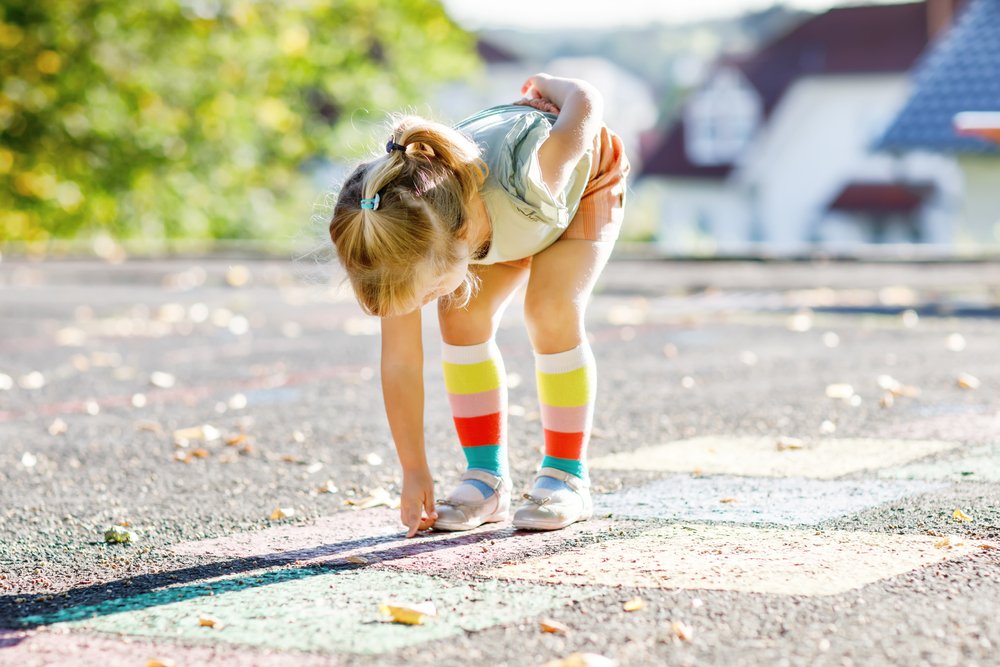Last Updated on January 25, 2024 by Gamesver Team and JC Franco

Hopscotch is among the oldest and most popular games in existence. Its simple and fun nature makes it a universal classic. A series of squares are drawn or etched out on the ground to create a court, a small object is thrown within one square, and you have to hop across to reach it without stepping on the lines.
Fun is only a part of what hopscotch has to offer. It can help your child develop gross and fine motor skills, balance, physical coordination, cognitive and social skills, body control and rhythm, and spatial awareness. Plus, it’s a great exercise that builds muscle strength and stamina.
Here are 16 benefits and advantages of hopscotch that’ll convince you to rush out and buy some chalk today!
1. Bilateral Coordination
Bilateral coordination involves being able to coordinate both sides of your body in an organized and controlled manner. You do it all the time without thinking about it when you tie your shoes, flip a page, fasten a seatbelt, or kick your kids’ shoes out of the way when carrying groceries through the front door.
Delays in bilateral development can be harmful to your child’s development. It can make it difficult to perform tasks and activities like dressing, buttoning, learning, writing, or climbing stairs. Hopscotch teaches a child to coordinate both sides of the body by hopping on one foot.
2. Balance
Balance involves maintaining a controlled body position when performing tasks. Holding controlled positions during dynamic (moving) and static (still) activities enables your child to function effectively across activities and environments.
Hopscotch is designed to challenge and develop your child’s sense of balance. They have to stay balanced on one leg, jump and land on the same foot as they move from one square to another. This requires balancing on a small base of support while the non-hopping side acts as a counterbalance.
3. Postural Control
Postural control describes how the nervous system regulates sensory information from other systems to produce adequate motor output for a controlled, upright posture. It makes it possible to make minor adjustments to changes in movement and position without compensatory motions.
Hopscotch rules include not stepping on the line or boundaries of the squares while hopping across. It can help your child master postural control and equilibrium. It forces them to jump, leap and stop with deliberate control while maintaining their gaze on the lines to avoid stepping on them.
4. Body Rhythm
Developing a good sense of rhythm has many developmental benefits for your child, including speech development, understanding math, and coordination. But it’s not enough to simply hear or feel a rhythm. Movement is a crucial factor that helps wire the brain to form long neural pathways.
Hopscotch involves maintaining a regular rhythm. It makes it easy for your child to develop a rhythmic pattern through the start and stop sequences of the game. In turn, it helps produce other capabilities and skills beyond movements, such as acquiring language through speech patterns and rhythms.
5. Spatial Awareness
When you’re spatially aware, you can perceive objects in the environment and how your body’s position relates to them. This helps your child when performing everyday activities at school and at home. It helps them interpret meanings like putting the pencil on top of the paper, or being at the front of the line.
Difficulties perceiving spatial relationships can affect motor skills, problem-solving, awareness, and daily living activities. In hopscotch, you have to land within the boundaries of the squares, which helps develop spatial awareness and an understanding of how they fit within the given limits.
6. Visual Motor Integration
Visual-motor integration involves being able to incorporate the perceived visual information with your motor skills. It makes it possible to correctly execute movements of the legs, arms, and body. These skills are integral to helping your child make coordinated and efficient movements.
The hopscotch game begins by tossing a small object like a bean bag or stone onto a square and hopping to that square. To get the pitch correctly, you have to see the target and translate the knowledge of distance and space to your arms and hand to aim accurately with enough force to reach the target.
7. Fine Motor Skills
Fine motor skills make it possible to coordinate between your small muscles like those of the fingers, hands, and wrists with your eyes. This enables your child to function effectively in different activities like grasping small objects, writing, or buttoning their clothes.

Hopscotch develops and challenges your child’s fine motor skills. The rules dictate that you have to retrieve your marker while remaining balanced on one foot. You have to hop to the square with the object, stop, bend over and pick up the piece, which requires delicate control of the finger muscles.
8. Gross Motor Skills
Gross motor skills involve the ability to do tasks that involve the large muscles in our legs, torso, and arms. This includes whole-body movements in different activities and requires the coordination of the muscles with the neurological system.
Playing hopscotch helps your child build gross motor skills like coordination, balance, reaction time, and body awareness. They have to control their entire body while balancing and moving on one foot from one square to the next. They also have to stop, bend over and start again without swapping their feet.
9. Cognitive Development
A lot of brainwork is involved when playing a game of hopscotch. This brainwork has to be coordinated with physical work and is excellent for cognitive development. The child gets to practice and learns using their senses together. Such skills are the foundation of cognitive processing and development.
Hopscotch helps your child reinforce memory and understand cause and effect. They have to visualize their target and know where to throw the marker, how to jump the squares, and which ones they’re supposed to avoid while remembering to stay on one foot throughout.
10. Adaptability
Adaptability involves adjusting readily to different conditions. When your child faces uncertainty or change, their level of adaptability dictates how well they handle the situation. The hopscotch game changes on each turn.
Your child has to work out a strategy of how they’re going to approach it each time. Unlike sedentary board games, these changes happen on the go. Children get to physically realize their plans as they develop them and think on their feet, literally.
11. Social Development
Children learn to navigate the social environment through play. Play makes it possible for your child to explore their environment with their peers through social interaction. Social play requires the child to express feelings and share ideas while noticing social cues, taking another’s perspective, and listening.
Hopscotch can be played alone or in groups. Encouraging group play is excellent for your children’s social development. They’ll be able to form friendships and learn cooperation and compromise according to the rules of the game, which require taking turns.
12. Character Development
Children learn to control their emotions and self-regulate while following a given set of rules in a game. All children naturally push themselves to be better and win in any given competition. Learning to manage their feelings when they lose is a vital skill that will help them throughout their life.
In hopscotch, children take turns winning or losing. They quickly learn that the fun doesn’t end whether they win or lose. The critical part is good sportsmanship and finishing their hopping turn regardless of the outcome.
13. Mathematics Skills
The hopscotch game involves numbers, and your child will naturally develop counting skills as they hop from one square to the next. Memorizing numbers as they jump up and down the court in an ascending or descending order happens based on observation and experience.
Hopscotch provides a kinesthetic way of learning numbers and can make math fun in various ways. The squares can be numbered or arranged in different orders or sequences. They can be used to teach addition, subtraction, division, or multiplication.
14. Physical Development
As you progress through the game of hopscotch, it gets more challenging and requires more physical exertion. It makes it possible for your child to push themselves to new physical achievements while building strength and stamina.
Leaping is a big part of hopscotch, and you may be required to jump over one or two squares at a time using one foot or two feet. Such routines are beneficial in working on your child’s calves and thighs together with the muscles supporting the knee joints.

15. Stress Reduction
Play is the best antidote for children and adults alike. Engaging in hopscotch will occupy the mind of your child entirely during play. This makes them calm and improves various aspects of their emotional well-being.
The physical actions involved are also an effective way for your body to deal with stress. As your child hops up and down, they excite the reward center of the brain. This results in the release of dopamine, a hormone that controls happiness.
16. Teaching Life Resilience
Resilience involves toughness or your ability to quickly recover from difficulties. Hopscotch can instill resilience in your child as they learn to never give up in pursuing their goals even when they’re faced with obstacles in their way.
Children have to jump or move around particular squares in the game to get to the marker. Sometimes they’ll slip and fall or land on the line and start all over again. Each time they play, they learn from their mistakes and attempt again.
Last Word
Hopscotch is the perfect example of the power of play. Draw up a court today and hop on to these advantages and benefits to boost your child’s development while having fun!

